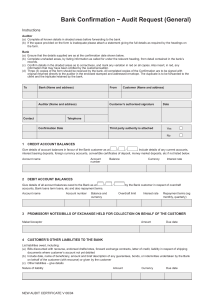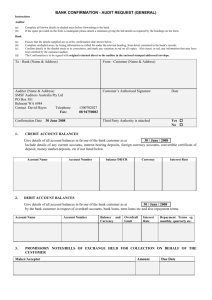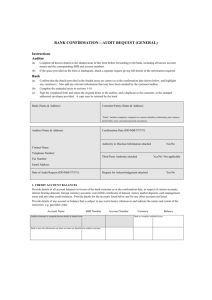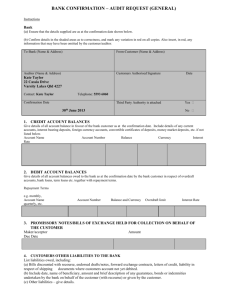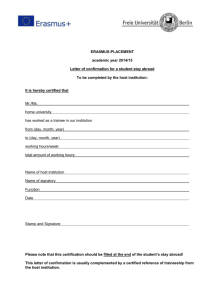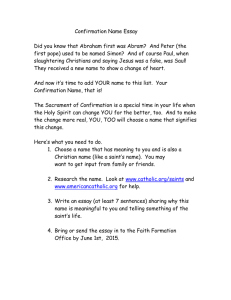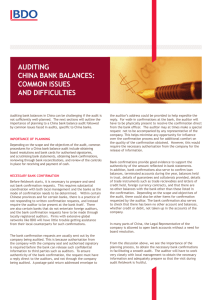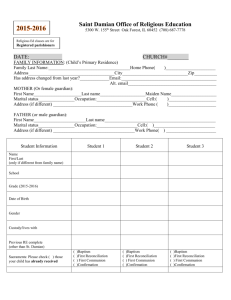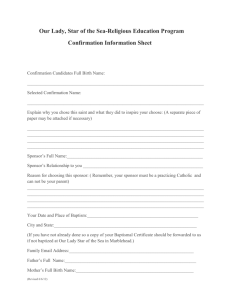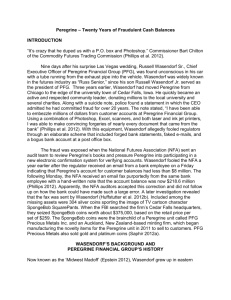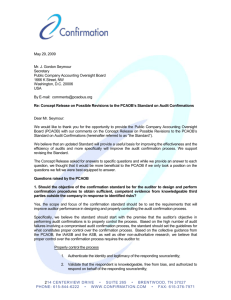Audit of Bank and Cash Cash and bank balances: • Liquid assets
advertisement
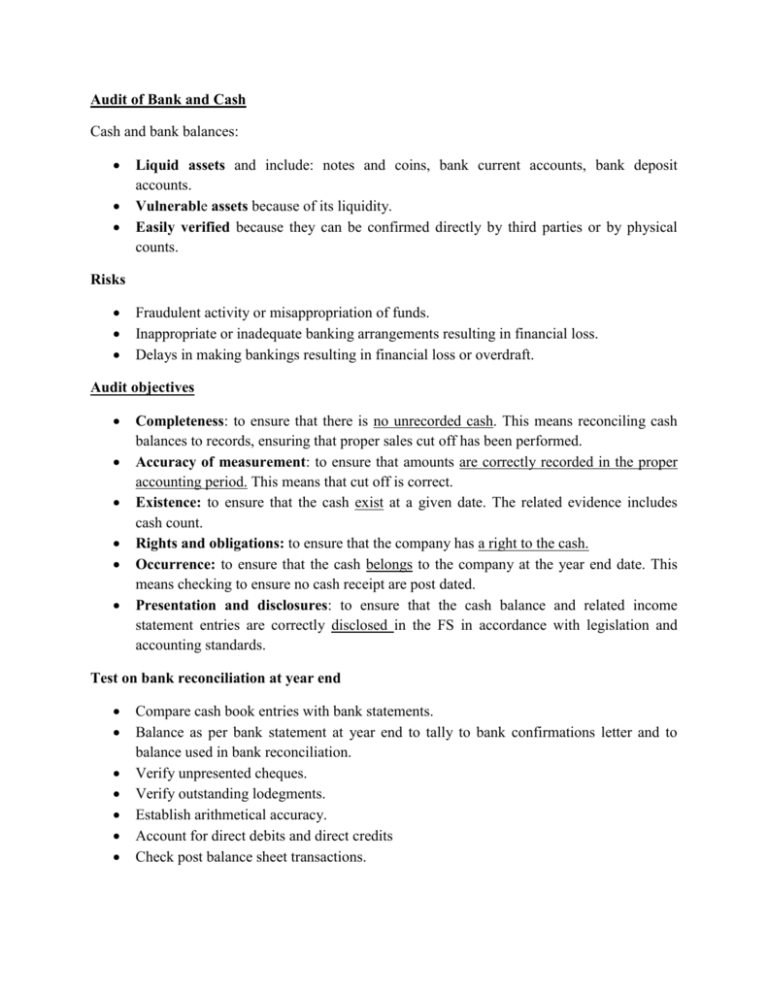
Audit of Bank and Cash Cash and bank balances: Liquid assets and include: notes and coins, bank current accounts, bank deposit accounts. Vulnerable assets because of its liquidity. Easily verified because they can be confirmed directly by third parties or by physical counts. Risks Fraudulent activity or misappropriation of funds. Inappropriate or inadequate banking arrangements resulting in financial loss. Delays in making bankings resulting in financial loss or overdraft. Audit objectives Completeness: to ensure that there is no unrecorded cash. This means reconciling cash balances to records, ensuring that proper sales cut off has been performed. Accuracy of measurement: to ensure that amounts are correctly recorded in the proper accounting period. This means that cut off is correct. Existence: to ensure that the cash exist at a given date. The related evidence includes cash count. Rights and obligations: to ensure that the company has a right to the cash. Occurrence: to ensure that the cash belongs to the company at the year end date. This means checking to ensure no cash receipt are post dated. Presentation and disclosures: to ensure that the cash balance and related income statement entries are correctly disclosed in the FS in accordance with legislation and accounting standards. Test on bank reconciliation at year end Compare cash book entries with bank statements. Balance as per bank statement at year end to tally to bank confirmations letter and to balance used in bank reconciliation. Verify unpresented cheques. Verify outstanding lodegments. Establish arithmetical accuracy. Account for direct debits and direct credits Check post balance sheet transactions. Banks reports for audit purposes (bank confirmation) Consist of confirmation of bank balances and other matters from the client’s bankers at the period end. Standard letters are used to confirm information with the bank where the client has dealings. Reasons for auditors to seek bank confirmation Bank confirmation provides evidence in respect of existence, ownership, and accuracy. It is a third party, written in relation to the balance sheet of assets and liabilities. Procedures o o o o o o o Request for confirmation issued to relevant banks: a request for a bank confirmation is to be issued on auditor’s letterhead and sent to all banks where the client has dealings. The request should be clear and concise. The request to be vague or precise: auditors should consider whether it is appropriate to list down balances and other information and request confirmation, or to request details of balances and other information. Control over the content and dispatch of requests for confirmation: is the responsibility of the auditor. However, the client will need to authorize disclosure of the relevant information. Replies should be sent direct to the auditor who should enclose a pre paid envelope to facilitate a speedy response. What precise information to be sought: the following categories of information may be sought: Balances due to or from the bank, the letter may give the account number, description and currency, and should request information on nil balances and accounts closed during the period. Collateral given or received, maturity and interest terms, unused facilities, lines of credit and any rights of offset or other rights or encumbrances. Terms and repayments conditions of loan and overdrafts. Contingent liabilities such as bills, acceptance, guarantees, and endorsements. Asset repurchase and resale agreements and options. Forward currency and other outstanding contracts. Assets held in safe custody any encumbrances over them. Check that replies are complete: in reviewing the bank’s reply it is important for auditors to check that the bank has answered all the questions information asked for in full. Cash on hand Verification The auditor should therefore plan to count all cash balances SIMULTANEOUS to prevent any ‘transfers’ of floats to hide discrepancies. Cash counts The following procedures should be applied: Surprise cash count: cash counts must be performed without the custodian being informed in advance e.g. on a surprise basis. Control all cash funds: until the completion of the count to prevent cash being transferred between funds to conceal deficiencies. Count in the presence of the custodian: to ensure the auditors cannot be blamed for any shortage. List each item in the fund: showing the denominations of notes and coins. The custodian should sign: the record as evidence of agreement. Agree the total to the petty cash book balance: and investigate any differences. QUESTION: Dec 06 (b) Jayne Co has a significant number of cash transactions and recent non-current asset purchases have been financed by a bank loan. This loan is repayable in equal annual instalments for the next five years. Required: (i) Explain the procedures to obtain a bank report for audit purposes from Jayne Co’s bank and the substantive procedures that should be carried out on that report. (5 marks) (ii) List the further substantive procedures that should be carried out on the bank balances in Jayne Co’s financial statements. (5 marks) Answers: Procedure to obtain bank confirmation letter (BCL): Bank confirmation mandatory for all bank accounts. BCL to be issued to all relevant banks. BCL to be on external auditor letterhead. BCL to be clear and concise. Client to authorize disclosure direct to auditor. Control over dispatch of BCL. Decide on information requested. (loan, currency, interest, security, dormant account) Check that replies are complete Substantive procedures on bank confirmation letter: Agree confirmed balance to bank reconciliation + bank reconciliation to general ledger, trial balance and financial statements. Agree interest due and receivable to GL, TB, profit & loss, balance sheet. Proper disclosure of loan details.( terms, interest rate, currency, current liabilities, non current liabilities)
